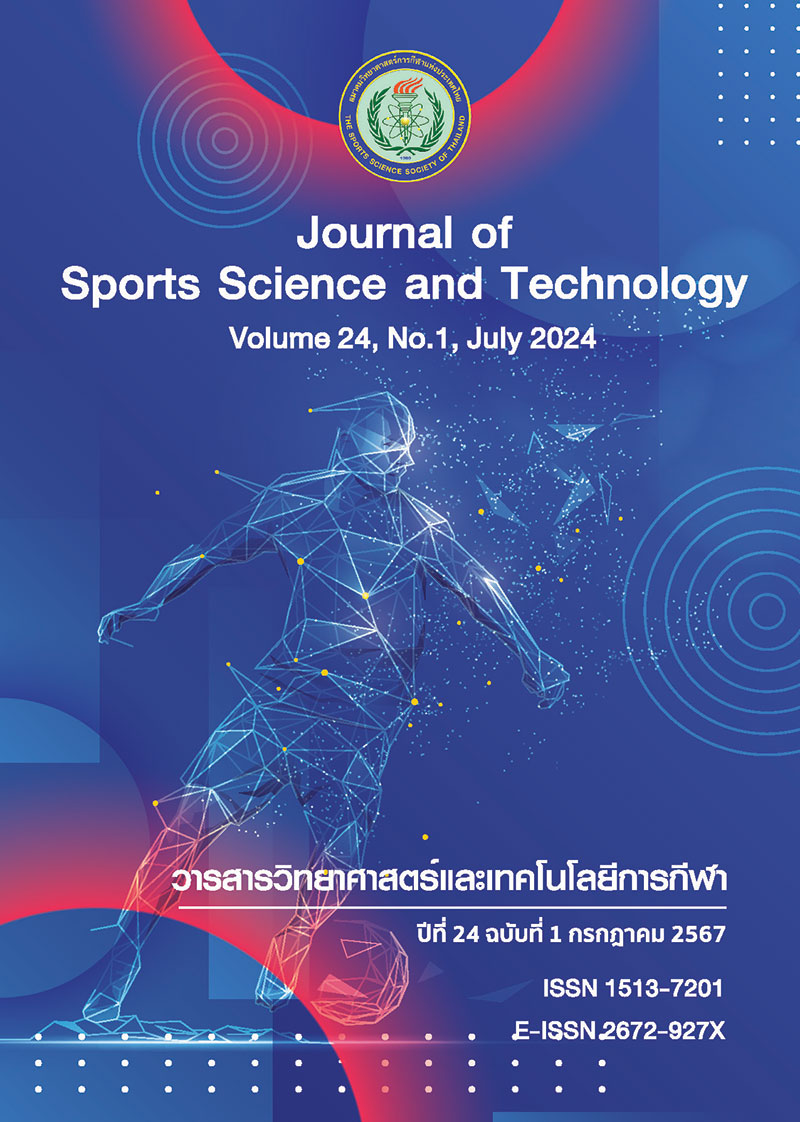ACCURACY OF INERTIAL MEASUREMENT UNIT POSITION FOR MEASURING THE HEAD AND TRUNK ANGLES
Keywords:
IMU, Walking, Sit to StandAbstract
The Inertial Measurement Unit (IMU) has garnered popularity for its application in measuring joint
angles during movement due to its cost-effectiveness and suitability for field testing. However, there are
instances where the IMU may require relocation, necessitating validation of the accuracy of its new placement.
Therefore, the objective of this study was to study the accuracy and reliability of the IMU angle sensor compared
with a ‘gold-standard’ retro-reflective motion capture system. Ten healthy volunteers (age 21.33±0.69 years,
weight 66.44±11.88 kg, height 173.11±0.05 cm.) performed the sit to stand (STS) and walking test (WT). Three
successful trials were averaged. Kinematic data were collected using ten optoelectronic cameras (OMC) and
four IMU sensors at 200 Hz. Cluster markers and IMU were attached on forehead, back of head, sternum and
C7. Bland-Altman plots demonstrated the point distribution within the interval to validate the IMU locations and
twice systems. The levels of significant were set at p < 0.05. Paired samples t-test showed no significant
difference between IMU vs OMC and IMU vs IMU in three planes during STS (p > 0.05), however, it showed
significant difference between IMU vs IMU in lateral flexion plane during WT (p > 0.05). In conclusion, these
findings demonstrate the feasibility of relocating IMU sensors for recording each body segment. The IMU can
be considered a valid and accurate for measuring the head and thorax range of motion However, the
attachment of the device to the skin emerges as a critical factor that can markedly influence data accuracy,
potentially leading to inaccurate.
(Journal of Sports Science and Technology 2024; 24(1):82-93))
(Received: 24 April 2024, Revised: 10 July 2024, Accepted: 16 July 2024)
Corresponding Author: Atipong MONGKOLPICHAYARUK
College of Sports Science and Technology, Mahidol University,
Nakhon Pathom, 73170, THAILAND
E-mail: atipong.mon@mahidol.edu
References
Godwin A, Agnew M, Stevenson J. Accuracy of inertial motion sensors in static, quasistatic, and
complex dynamic motion. 2009
Liengswangwong W, Lertviboonluk N, Yuksen C, Laksanamapune T, Limroongreungrat W,
Mongkolpichayaruk A, Tharawadeepimuk K, Jamkrajang P, Sook-Oum P, Watcharakitpaisan S. Comparing the
Efficacy of Long Spinal Board, Sked Stretcher, and Vacuum Mattress in Cervical Spine Immobilization; a
Method-Oriented Experimental Study. Arch Acad Emerg Med. 2023;11(1).
Rattanakoch J, Samala M, Limroongreungrat W, Guerra G, Tharawadeepimuk K, Nanbancha A,
Niamsang W, Kerdsomnuek P, Suwanmana S. Validity and Reliability of Inertial Measurement Unit (IMU)-
Derived 3D Joint Kinematics in Persons Wearing Transtibial Prosthesis. Sensors. 2023 Feb 3;23(3):1738.
Sibson BE, Banks JJ, Yawar A, Yegian AK, Anderson DE, Lieberman DE. Using inertial measurement
units to estimate spine joint kinematics and kinetics during walking and running. Sci Rep 2024 Jan 2;14(1):234.
Bartoszek A, Struzik A, Jaroszczuk S, Woźniewski M, Pietraszewski B. Comparison of the
optoelectronic BTS Smart system and IMU-based MyoMotion system for the assessment of gait variables. Acta
Bioeng Biomech 2022 Jan 1;24(1).
Dufour JS, Aurand AM, Weston EB, Haritos CN, Souchereau RA, Marras WS. Dynamic joint motions in
occupational environments as indicators of potential musculoskeletal injury risk. J Appl Biomech. 2021 Mar
;37(3):196-203.
Vitali RV, Cain SM, Ojeda LV, Potter MV, Zaferiou AM, Davidson SP, Coyne ME, Hancock CL, Mendoza
A, Stirling LA, Perkins NC. Body-worn IMU array reveals effects of load on performance in an outdoor obstacle
course. PLoS One. 2019 Mar 21;14(3):e0214008.
Nolte PC, Uzun DD, Häske D, Weerts J, Münzberg M, Rittmann A, Grützner PA, Kreinest M. Analysis
of cervical spine immobilization during patient transport in emergency medical services. Eur J Trauma Emerg.
Surg.. 2021 Jun;47:719-26.
Lin YT, Lee HJ. Comparison of the lower extremity kinematics and center of mass variations in sit-tostand and stand-to-sit movements of older fallers and nonfallers. Arch Rehabil Res Clin Transl. 2022 Mar
;4(1):100181.
Teufl W, Miezal M, Taetz B, Fröhlich M, Bleser G. Validity, test-retest reliability and long-term stability
of magnetometer free inertial sensor based 3D joint kinematics. Sensors. 2018 Jun 21;18(7):1980.
Pavan EE, Frigo CA, Pedotti A. Influence of an eccentric load added at the back of the head on headneck posture. Gait Posture. 2013 Sep 1;38(4):951-5.
Wu G, Van der Helm FC,
Veeger HD, Makhsous M, Van Roy P, Anglin C, Nagels J, Karduna AR,
McQuade K, Wang X, Werner FW. ISB recommendation on definitions of joint coordinate systems of various
joints for the reporting of human joint motion—Part II: shoulder, elbow, wrist and hand. J Biomech. 2005 May
;38(5):981-92.
Niswander W, Wang W, Kontson K. Optimization of IMU sensor placement for the measurement of
lower limb joint kinematics. Sensors. 2020 Oct 22;20(21):5993
Bland JM, Altman DG. Measuring agreement in method comparison studies. Statistical methods in
medical research. 1999 Apr;8(2):135-60.
Yoon TL, Kim HN, Min JH. Validity and reliability of an inertial measurement unit–based 3-dimensional
angular measurement of cervical range of motion. J Manip Physiol Ther. 2019 Jan 1;42(1):75-81.






